Magic: The Gathering is a beloved, yet complicated, game that can get confusing when trying to understand even the most basic of rules. Protection is one of these often confused mechanics.
Protection is an ability that affects a player or permanent on the battlefield. It is referred to as “Protection from…” as it can only protect from certain types of magic as often stated by a specific color. It is a static ability that blocks specified magic, characteristic value, or card.
That being said, it can often get a bit more complicated than just that. How do you use it? What are its limitations? Keep reading to learn all you need to know about protection in MTG.
What Does Protection Mean in MTG?
Protection in MTG is an effect that appears on a card and is usually active when a permanent is in play.
The protection attribute defends a card, to a certain extent, against what is specified. The parameters of the protection vary from card to card, but often, protects against a specific Magic color, card, effect, damage, enchantment, or being targeted or blocked.
Most often a card will say “protection from [color].” This means a card with that protection written on it cannot be blocked, damaged, enchanted, or affected in other ways by a creature or card of that specific color.
Other than physically blocking, protection is the most common and viable form of defense in Magic The Gathering, and yet is also the most misunderstood mechanic for many.
How Does Protection Work?
Protection has a specific set of rules using the acronym DEBT.
- Damage by sources with the specified quality is prevented
- Enchantments or equipments
- Blocking by creatures with the specified quality is prevented
- Targeting by spells or abilities from sources of the specified ability is prevented
This is simply a clever way to remember what the ability protection prevents.
While “protection from [color]” is most common, some cards also have the ability protection from:
- [Card Name]
- [Card Type]
- [Subtype]
- [Supertype]
These abilities protect all cards of like-type. It is possible for protection to have two qualities listed as well such as, “protection from blue and from demons.” This card would be protected against blue cards and demon cards in all the ways listed in the DEBT acronym.
However, beware, this condition applies to your own creatures as well. If you are wanting to enchant one of your creatures, but they are protected from the color you are trying to use to cast the spell you will not be able to enchant your creature, even if the effect is a positive one.
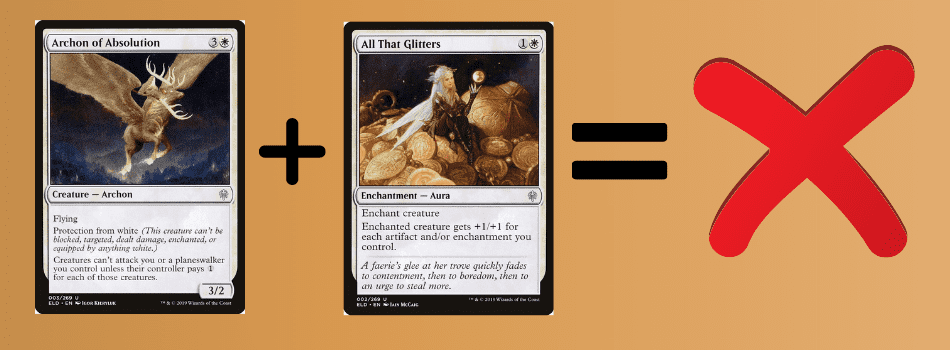
For example, Archon of Absolution has protection from white, so no other card paid for with white mana can affect it. So if you have Archon of Absolution in play and you want to enchant it with All that Glitters, you will not be able to.
If you want more information on a general overview of how Protection works, check out this official video guide by the creative team behind Magic The Gathering themselves.
Does Protection Stop Boardwipes / Wrath Effects?
This is a tricky question and one you can find many debates on. Does protection stop board wipes/wrath effects? First, what are board wipes and wraths?
Traditional board wipe cards destroy certain things from the battlefield. Some target creatures, others target artifacts or enchantments or lands, and so on and so forth.
Most board wipe cards have a specific color, (though there are several colorless board wipes) and thus should be blockable by protection from that same color, right?
It is a little more complicated than that.
When looking at our DEBT acronym we can see exactly what protection protects against. However, board wipes are not doing any type of damage, enchantment, block, or target. In fact, usually, they are simply clearing the board of specific cards.

This means a card such as Blood Knight can do nothing against the card Wrath of God even though it has protection from white. The Wrath of God card simply says “Destroy all creatures.” It does not state any type of effect protected in the DEBT rule and because of this protection effects, even of the same color, would not save your cards.

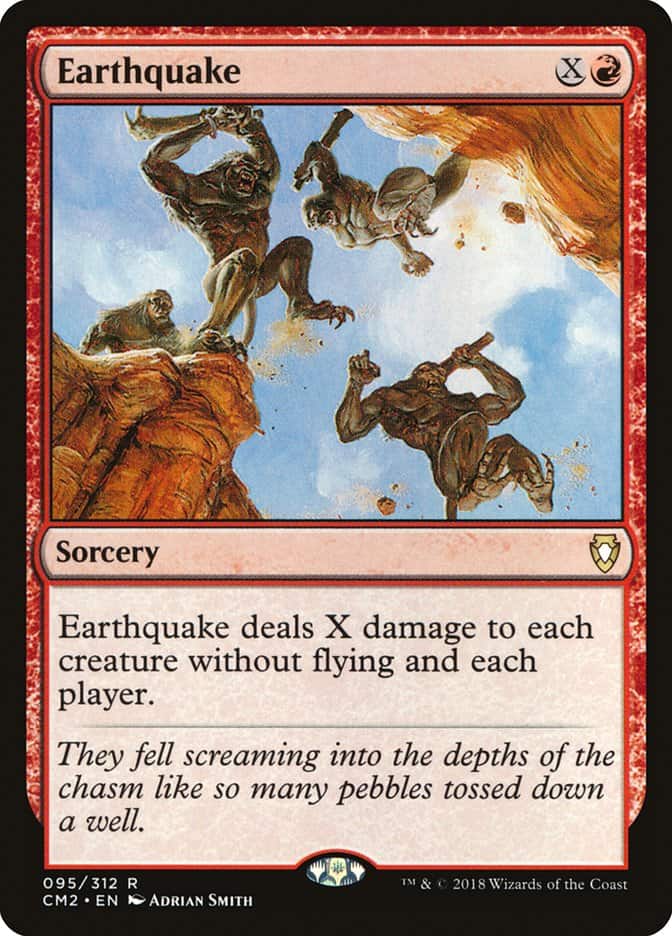
Board wipes that do damage like Blasphemous Act or Earthquake are stopped by Protection, since they do damage and protection prevents damage from related sources.
Board wipes, other than those with the Overload mechanic, that say the words “X target” or “any number of targets in the text they have relating to the actual wiping of the board such as Curse of Swine also miss creatures with protection because protection stops spells from targeting the creatures that have it.)
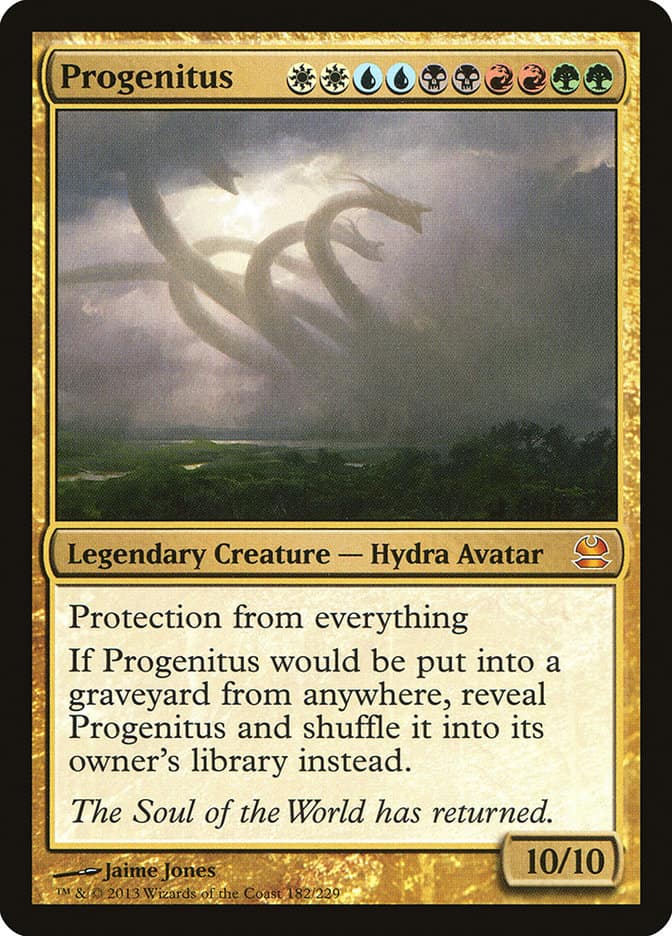
What Does Protection from “everything” Mean?
Protection from “everything” is another rare effect in Magic and again, it can only work within the parameters of DEBT.
Sadly even protection from “everything” will not save you from Wrath of God and other cards that do not damage, enchant, equip, block, or target.
Progenitus is one such card. It has the illustrious protection from “everything,” and is thus impervious to most forms of attacks. Notice the “most.”
Its ability to withstand all DEBT is still a fantastic effect. One of the only things that would clear a card like this would be to use a board wipe or a card such as Cruel Edict, which sacrifices one of your opponent’s creatures.
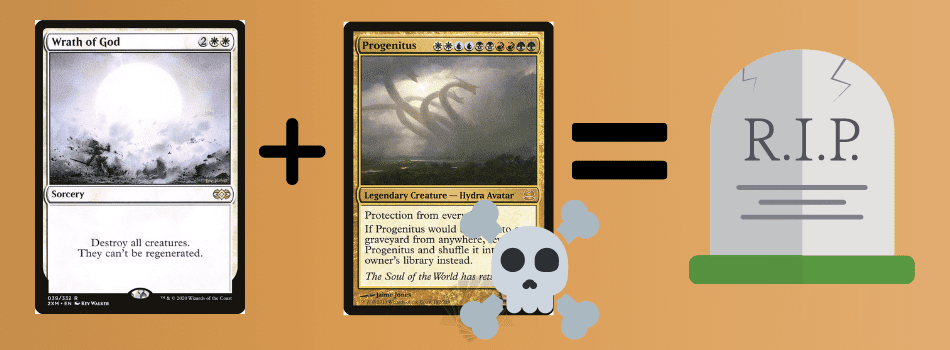
Some other cards are also protected from “all colors” such as Iridescent Angel. This is a simple and straightforward effect as long as you understand DEBT. Any card with this text written on it cannot be damaged, enchanted, equipped, blocked, or targeted by any card of any color. (That has a color. There are lots of cards with no color.)
However, pay attention to the text. If a card is protected from “creatures of all colors,” and not “all colors,” it can still be targeted by colored cards that aren’t creatures.
Trample And MTG Protection – How Does It Work?
Trample and protection’s relationship in actual battle is a complicated one.
Trample is not included in the DEBT description and so, following the previously stated rules with board wipe and wrath, it would still affect your creatures, right?
Once again, not exactly.
Trample works in an odd way by assigning damage before it is actually applied. Trample has a rule where you must assign lethal damage to your opponent, but if you have power remaining then you use it to attack the player or planeswalker directly.
This means if you have a 7/7 card with trample and you are attacking a 3/3 card, you would then do 4 damage to the player.
But what if that card has protection from the color of your trample? In this case, you would still assign all your damage but not deal it toward the protected card.
For example, if you have a 2/2 card with protection from green and your opponent attacks it with a 4/4 green trample card, then your card would be assigned 2 damage and you would be assigned 2. However, you would be the only one taking damage since your card would then be protected from DEBT, specifically from damage in this instance.
Let’s take a look at a more specific example.

If your opponent attacks you using Argothian Wurm (with a power of 6/6 using trample), and you block with Zombie Outlander who has a power of 2/2, 2 of Argothian Wurm’s power would be assigned to your Zombie Outlander, and 4 would be assigned to you. Then the damage would be taken.
However, Argothian Wurm is a green card, and Zombie Outlander has protection from green. This means that your Zombie Outlander would not take that damage, but you would still take the 4 points of damage.
There are also some cards that will give you the effect “you have protection.” This means that the DEBT rule is applied to you instead of a specific creature or card. In this instance you, yourself, can’t be damaged, enchanted, equipped, blocked, or targeted.
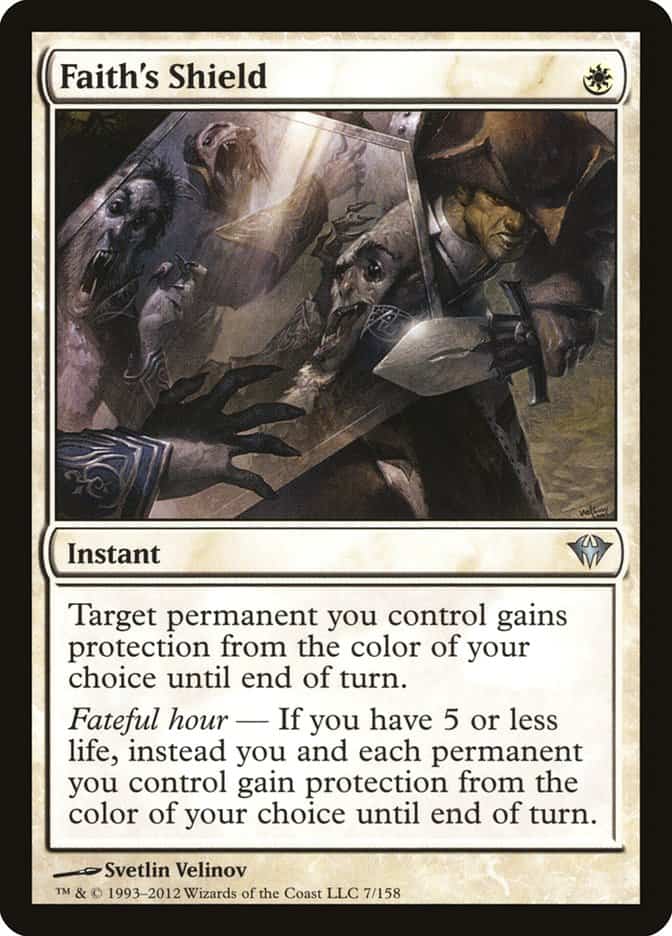
So if, in our hypothetical situation above, you had Faith’s Shield in play and only had 5 or less life, you gain protection from the color of your choice until the end of turn. If you chose green, you would be completely protected from the opponent’s Argothian Wurm.
Protection also prevents Deathtouch of the same color seeing as how this effect only changes the amount of damage received and does not use any other words. Because of this, it obviously falls under the DEBT umbrella rule.
History of Protection
Protection started as a simple effect that was meant to highlight the opposing colors.
A card would usually protect from an enemy color, and not a color that allied the color of the protected card. This unspoken rule has since been ignored and many protection cards can be found protecting from any and all colors in the MTG color wheel.
There was a period of time in 2015 when The Wizards of the Coast attempted to phase out the protection effect. It was meant to be replaced with “hexproof from X.” Hexproof meant it would not be targeted by any spell or abilities your opponent’s control.
Protection has since been making its way back into newly published standard legal sets though admittedly a little slowly.
Popular MTG Protection Creatures
Since protection cards have been around for so long, it might be a daunting challenge to sift through the more than 334+ options in the Magic The Gathering repertoire. Here are some of the most popular or famous protection cards found.
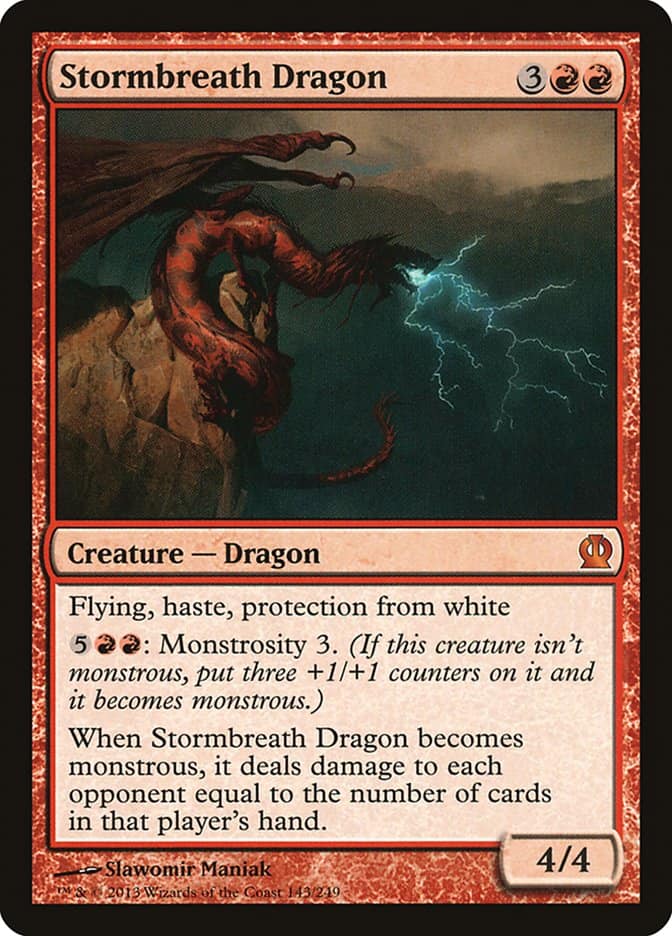
Stormbreath Dragon: This red dragon is a classic, beloved card with protection from white.
As protection from white is most often used due to the nature of white removal cards, this puts many protection from white cards at a highly desired rank. This card, however, can also deal damage to each opponent equal to the number of cards you have in your hand.
So play your cards right – pun intended – and you could deal out a monstrous amount of damage with this one.
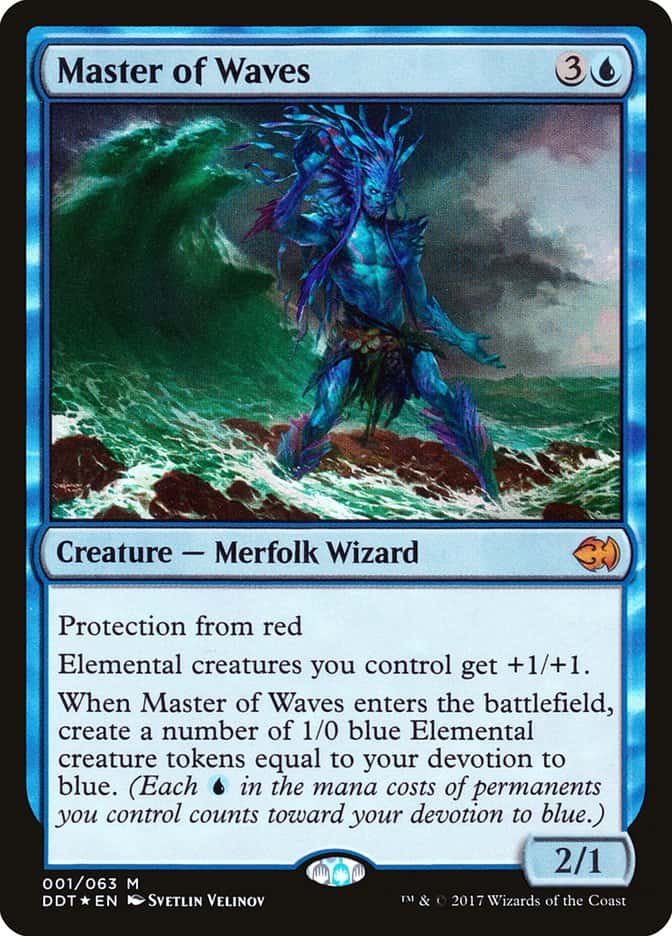
Master of Waves: Another classic, this Merfolk wizard has protection from red, and with his powerful history in the game, many have had the opportunity to find tried and true combos and strategies to play him in.

Akroma, Angel of Wrath: This card has a plethora of effects that all add together to make it an extremely powerful 6/6 creature.
Along with its vigilance, trample, haste, flying, and first strike effects, it also has protection from both black and red, making this a pricy legendary card, and a wishlist item for your deck.

Animar, Soul of Elements: This card has protection from both white and black.
It is a Temur-colored Commander card that is desirable for its protection ability alone. However, it also “ramps you.” This is a colloquial term for increasing your access to mana, and thus the number of cards you can play on your turn.
Protection from Black and White would be pretty useless on Animar if he didn’t do anything else, which gives it a steady advantage as well as a spot on this list.

Progenitus: As mentioned above, is a mythic rare five-colored 10/10 power card with protection from everything. As you can imagine, it is a pretty desired card for any player’s deck.
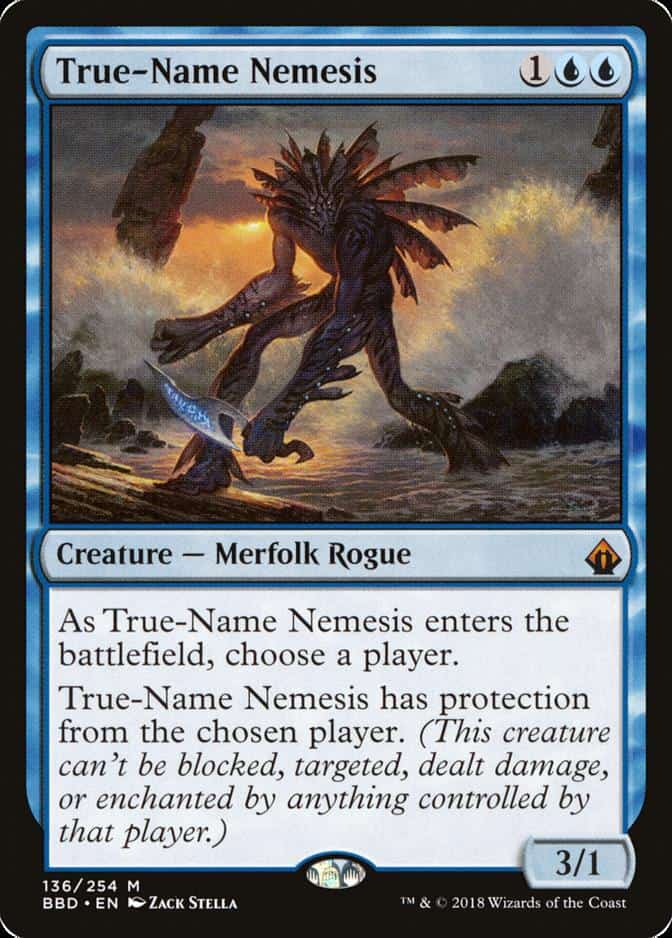
True-Name Nemesis: This is a card that bends the perception of protection. While it will still only affect DEBT, it gives you the ability to choose a player from which it will have protection from.
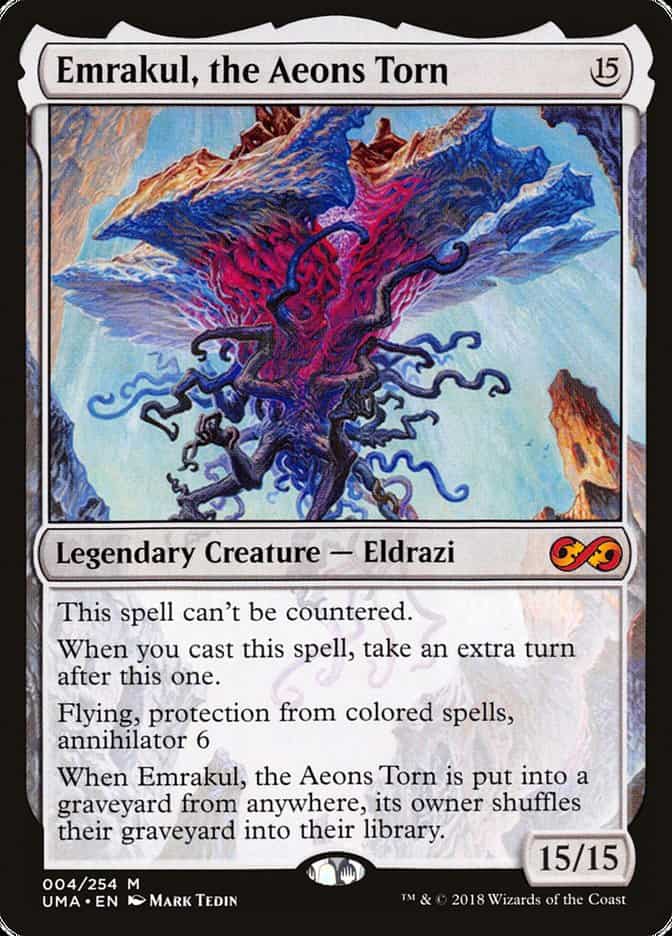
Emrakul, the Aeons Torn: This Eldrazi Legendary has one of the highest power stats of the entire game.
At an incredible 15/15, it also has protection from colored spells, flying, allows for an extra turn when cast, cannot be countered, and has annihilator 6 which forces your opponent to sacrifice six permanents after every attack of his.
This makes this card one of the most powerful creatures out there, and with its ability to be shuffled back into your library if sent to the graveyard, it holds the well-deserved title of best overall Magic creature. This card is banned in commander format.
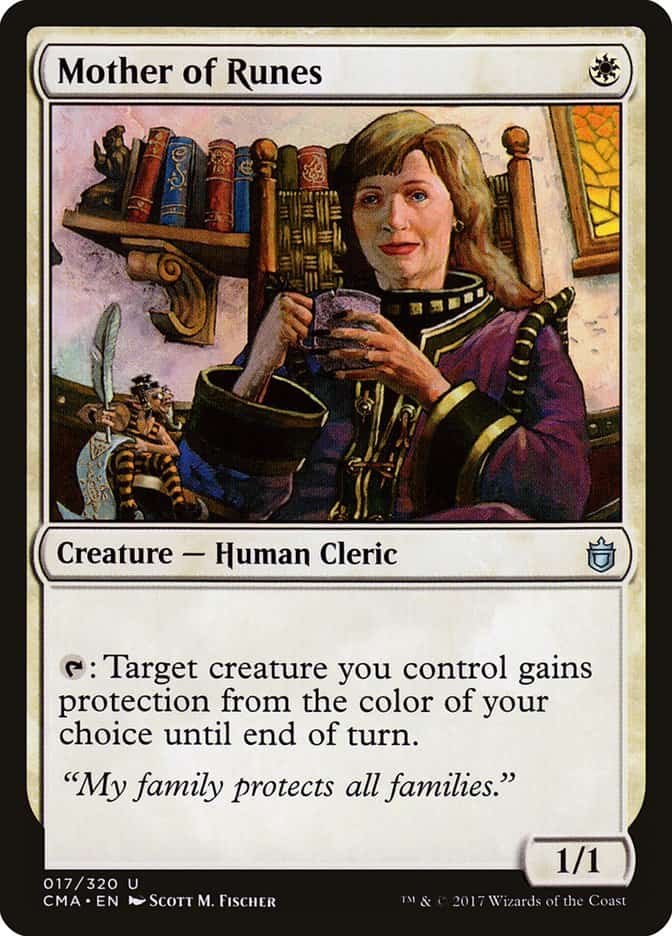
Mother of Runes: While most of the cards listed above have strong offensive power, protection is one of the strongest defensive options in the game.
Cards like the Mother of Runes lend their impressive defensive power to you in this form. This card allows you to choose another creature you control and give it protection from a color of your choice.
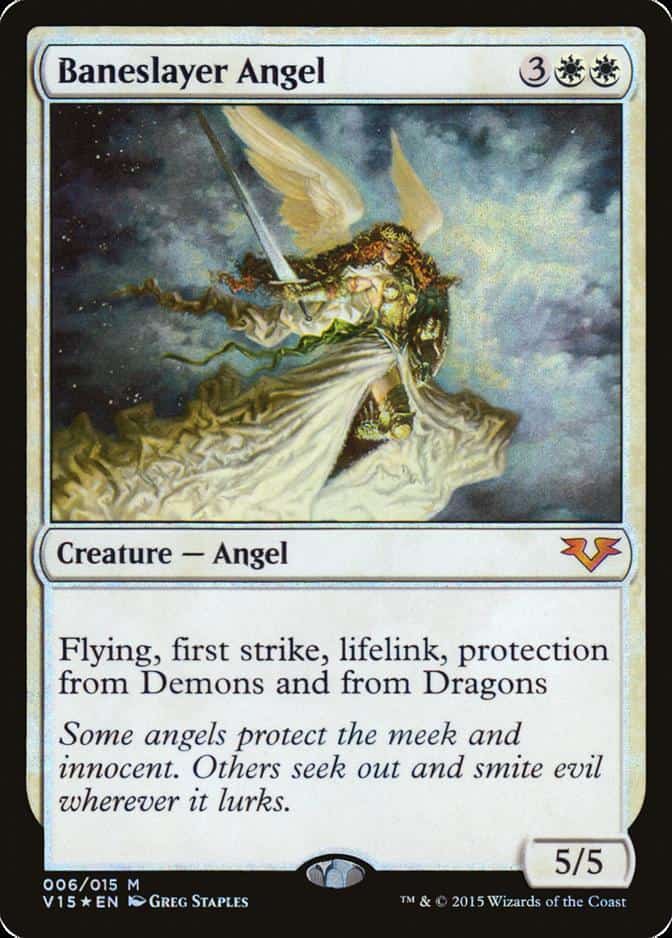
Baneslayer Angel: This card has protection from dragons and demons, as well as a few other keywords that make this card a common, yet powerful, protection card.
MTG Protection Official Rules
702.16 Protection (Source)
702.16a Protection is a static ability, written “Protection from [quality].” This quality is usually a color (as in “protection from black”) but can be any characteristic value or information. If the quality happens to be a card name, it is treated as such only if the protection ability specifies that the quality is a name. If the quality is a card type, subtype, or supertype, the ability applies to sources that are permanents with that card type, subtype, or supertype and to any sources not on the battlefield that are of that card type, subtype, or supertype. This is an exception to rule 109.2.
702.16b A permanent or player with protection can’t be targeted by spells with the stated quality and can’t be targeted by abilities from a source with the stated quality.
702.16c A permanent or player with protection can’t be enchanted by Auras that have the stated quality. Such Auras attached to the permanent or player with protection will be put into their owners’ graveyards as a state-based action. (See rule 704, “State-Based Actions.”)
702.16d A permanent with protection can’t be equipped by Equipment that have the stated quality or fortified by Fortifications that have the stated quality. Such Equipment or Fortifications become unattached from that permanent as a state-based action, but remain on the battlefield. (See rule 704, “State-Based Actions.”)
702.16e Any damage that would be dealt by sources that have the stated quality to a permanent or player with protection is prevented. (Source)
702.16f Attacking creatures with protection can’t be blocked by creatures that have the stated quality.
702.16g “Protection from [quality A] and from [quality B]” is shorthand for “protection from [quality A]” and “protection from [quality B]”; it behaves as two separate protection abilities. If an effect causes an object with such an ability to lose protection from [quality A], for example, that object would still have protection from [quality B].
702.16h “Protection from all [characteristic]” is shorthand for “protection from [quality A],” “protection from [quality B],” and so on for each possible quality the listed characteristic could have; it behaves as multiple separate protection abilities. If an effect causes an object with such an ability to lose protection from [quality A], for example, that object would still have protection from [quality B], [quality C], and so on.
702.16i “Protection from everything” is a variant of the protection ability. A permanent with protection from everything has protection from each object regardless of that object’s characteristic values. Such a permanent can’t be targeted by spells or abilities, enchanted by Auras, equipped by Equipment, fortified by Fortifications, or blocked by creatures, and all damage that would be dealt to it is prevented.
702.16j “Protection from [a player]” is a variant of the protection ability. A permanent with protection from a specific player has protection from each object the player controls and protection from each object the player owns not controlled by another player, regardless of that object’s characteristic values. Such a permanent can’t be targeted by spells or abilities the player controls, enchanted by Auras the player controls, equipped by Equipment the player controls, fortified by Fortifications the player controls, or blocked by creatures the player controls, and all damage that would be dealt to it by sources controlled by the player or owned by the player but not controlled by another player is prevented.
702.16k Multiple instances of protection from the same quality on the same permanent or player are redundant.
702.16m Some Auras both give the enchanted creature protection and say “this effect doesn’t remove” either that specific Aura or all Auras. This means that the specified Auras can legally enchant that creature and aren’t put into their owners’ graveyards as a state-based action. If the creature has other instances of protection from the same quality, those instances affect Auras as normal.

